According to research by theItalian Publishers Association (AIE) in collaboration with the Center for Books and Reading (CEPELL) presented at Più libri più liberi, the National Fair of Small and Medium-sized Publishers in Rome organized by the AIE, up to age 9 Italians would be great readers, then a decline. There are 5.9 million young readers - listeners in Italy from 0 to 14 years old, or rather Italians buy a lot of books for their children. “For the first time,” explained the head of AIE’s study office, Giovanni Peresson, "we explore the consumption of publishing products in infants, through tactile books, and we give an account of an evolution that must make us reflect on the strengthening of policies to support reading, to understand on which groups it is best to target them and how."
For Angelo Piero Cappello, director of the Center for Books and Reading, “readers are not born, it is useless to pretend that they are. On the contrary, it is the task of those who program public policies to encourage reading to give birth to readers: by incentivizing and supporting reading (listening) in infancy, preschool and preadolescence, taking into account, however, that today’s reading processes no longer remain limited to the ebook or the tactile book, let alone the picture book: what is changing is the concept of the book-increasingly integrated between different media-which drags with it the concept of reading, which is increasingly digital: to the paper book, understood in the singular, are added hybrid books, which simultaneously use different sensorialities (hearing, touch, sight), and which push the budding reader toward an increasingly simultaneous and plural cognition of the world.”
In the 0-14 age group, readers (or listeners) make up 77 percent of the total, and each of these reads in very different ways: 72 percent read print books (including illustrated books), 10 percent e-books, 2 percent physical audiobooks, 3 percent audiobooks on platforms, 18 percent use educational and narrative apps, and 34 percent (in the 0-4 age group) read tactile books.
Behind these numbers, however, is a highly variable age trend: between 0-3 years old readers are 77%, rising to 93% in the 4-6 year old range and dropping to 84% in the 7-9 year old range. Between the ages of 10 and 14 they drop again toward 65 percent, a decline that will then continue to touch 51 percent in the 15-17 age group (a group that is not the subject of this research, however).
The 77 percent average hides differences in gender as well: 80 percent of girls are readers versus 75 percent of boys. As for reading intensity, just under half (42%) read between 1 and three books a year, 30% between 4 and 6 books, 20% between 7 and 11 books, and 8% 12 or more books. The vast majority, 69% read only print or tactile books while as many as 20% also read or listen in foreign languages. In addition, 37% choose for themselves what to read.
Reading, however, although a popular activity, does not seem to be very passionate about it among the youngest: according to parents’ ratings, on a scale of 1 to 10, the average rating for their children’s books is 5.6. For 54 percent of children, however, the rating is above 6.
 |
| Italians buy lots of books for their children, ages 0-14: research by AIE |
Warning: the translation into English of the original Italian article was created using automatic tools. We undertake to review all articles, but we do not guarantee the total absence of inaccuracies in the translation due to the program. You can find the original by clicking on the ITA button. If you find any mistake,please contact us.